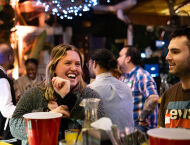Eat

What the Funk! Sour Beers 101
October 29, 2015 @ 12:00am
Sour beers have been popular in Belgium for decades but have only recently caught mainstream attention in the United States. But what exactly is a sour beer?
Beer is comprised of four main ingredients: water, malt, hops and yeast. Yeast plays a large role in the brewing process by not only converting the sugar into alcohol and carbon dioxide, but also by dramatically influencing the beer’s taste. For example, many classic Belgian beers are known for a fruity flavor which comes from the type of yeast used and not the addition of fruit.
A lot of mass produced beers are fermented with a single culture, or specific type of yeast, usually top fermenting (ale yeast) or bottom fermenting (lager yeast). Sours are brewed with what is called a wild culture, meaning one or several types of yeast or bacteria are used to ferment the beer, giving it the funky or tart flavor that characterizes this style of beer. This can be done through either controlled or open air fermentation. Controlled fermentation is the more common practice, during which brewers carefully add specific types of yeast and bacteria to the beer. As the name implies, during open air fermentation, brewers literally open the tanks to let wild yeast into the wort. Now that you know the basics, here is a deeper dive into the world of sours…
Yeast and Bacteria Associated with Sour Beers
Brettanomyces is a strain of yeast that can be used in primary or secondary fermentation and will give beer a funky, not necessarily sour, flavor. It is an unpredictable and slower working yeast but yields unique results when used properly. There are five different species of Brettanomyces, or Brett, but only two of them are used in brewing, bruxellensis and anomalus. Characteristics commonly associated with Brett are barn yard or horse blanket aromas.
Lactobacillus is a lactic acid bacterium that, when used in brewing, converts sugar to lactic acid instead of alcohol. Lacto, as it is often referred to, is the reason a beer is sour. It is frequently used in the production of Lambics, American Wild Ales and Berliner Weisse. Lactobacillus can also be found in yogurt.
Pediococcus, like Lactobacillus, converts sugar to lactic acid. However, Pediococcus creates a harsher and more complex sour taste and often produces buttery or undesirable flavors. As a result, it is usually combined with Brettanomyces to balance out the unwanted notes. It is common in Flanders Red Ales.
Sour Facts
A coolship is an open fermentation vessel that provides more surface area for the beer to cool while also allowing exposure to wild yeast. Although coolships are common in Belgium, only a select few American breweries possess these vessels. Allagash, Russian River, Jester King and Anchor Brewing Company can all claim coolships in their brewing repetoire.
Before Louis Pasteur and the invention of modern refrigeration, all beer experienced wild fermentation. In other words, all beer was at one point sour or funky to a certain degree. It was not until the invention of pasteurization in 1864 that brewers learned the unwanted bacteria in beer could be killed off by heat.
Although Brettanomyces is often sought out and embraced in the beer world, it is feared by winemakers because an infection can cause havoc in the facility and destroy the wine.
Established in 1900, the legendary Brouwerij Cantillon is widely considered the best sour beer producer in the world. The brewery is currently operated by the founder’s great-great-grandson and still contains some of the original brewing equipment. They specialize in lambics and age each one for a minimum of three years.
Sour Styles to Look For
Berliner Weisse a classic German wheat beer that is soured by lactobacillus and is occasionally served with flavored syrups to mellow out the tartness and acidity. They are known for their lower ABV and make for a great session beer. Try Sorry Chicky(4.4% ABV) by Burley Oak Brewery, MD.
Gose is another German sour wheat beer that uses lactobacillus. However this style is brewed with salt and coriander to mimic the high mineral content of the German waters the beer was originally brewed with. Gose beers typically have low to medium alcohol content, high acidity and tart-lemon flavors. Try Blood Orange Gose (4.2% ABV) by Anderson Valley Brewing Company, CA or Hardywood Watermelon Gose(5.2% ABV) by Hardywood Park Craft Brewery, VA.
American Wild Ale is a type of sour beer brewed in America that use Brettanomyces or bacteria to achieve their funky or sour flavor. They are often compared to Belgian Lambics (think Cantillon). Try Tart of Darkness (7% ABV) by The Bruery, CA, Lolita (9% ABV) by Goose Island Beer Company, IL or Bramble Frumenti (7%) by Lost Rhino Brewing Company, VA.
Flanders Oud bruin means “old brown” which refers to the aging process that can take more than a year. Oud Bruins undergo secondary fermentation and are often aged in barrels before being bottle conditioned. Try Lips of Faith – La Folie (7% ABV) by New Belgium Brewing, CO or Petrus Oud Bruin (5.5% ABV) by Brouwerij De Brabandere, BEL.






